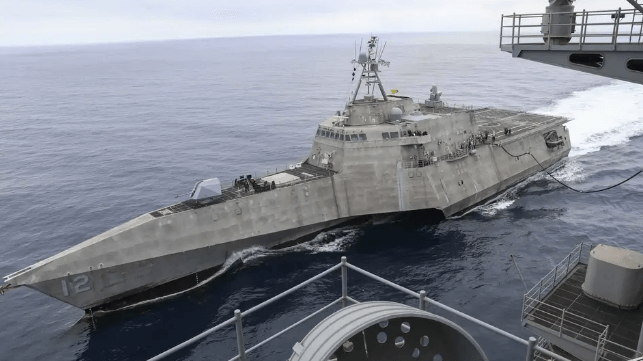Report: Nearly Half of Independence LCS Hulls Have Isolated Cracking

Both classes of the U.S. Navy's littoral combat ship (LCS) program have come under fire for perceived weaknesses over the last 12 years, including their limited armament, reduced survivability and high maintenance costs. The Navy recently proposed decommissioning the entire active fleet of the Freedom-class, the steel monohull version of the LCS concept; Navy Times now reports that the service has discovered what may be a class-wide issue aboard the Independence-class, which is slated to remain in operation.
The Freedom-class hulls suffer from a technical issue with their combining gear, the complex gearbox that transfers power from the ship's diesel and gas turbine engines to drive its powerful waterjets. To fix it, the Navy's contractors must remove systems surrounding the gearbox, replace some of the unit's ball bearings with journal bearings, then reassemble the unit and restore all disassembled components. If the Navy retires the already-delivered majority of the Freedom class instead, it would avoid any expense associated with this repair - and reduce the operating cost of a platform it says that it no longer needs.
The Independence-class is an entirely different ship, built from a different material by a different yard, but this class may also have a serious flaw. According to documents obtained by Navy Times, six out of the 13 delivered vessels in the class suffer from cracking in "higher-stress areas of the structure," and all of them "have under-designed structural defects" at frames 36 and 45.
These problem spots are located above the waterline, the Navy told the outlet, but they are serious enough that at least one LCS - the USS Omaha - is not allowed to operate at sea when wave heights exceed eight feet (Sea State 4). Omaha is stationed in U.S. 3rd Fleet, where winter Pacific storms can generate wave heights of twice that level or more.
Even in calm seas, Omaha's command has restricted her speed to less than 15 knots - a fraction of her reported design speed of 44 knots.
Omaha's hull cracking issues are centered on the area where “the shell plate vertical flat bar meets the deck between frames 35-36 and 45-46," documents obtained by Navy Times indicate. The crew is instructed to watch for any crack growth beyond six inches. Despite the cracking, a Naval Sea Systems Command spokesperson told the outlet, the Navy considers all Independence-class LCS vessels to be safe and mission-capable; all affected vessels will be repaired with thicker plating, and all remaining deliveries will incorporate the modification.
Both LCS classes were designed for speed and affordability, and armor and armament were deemphasized in order to achieve top-end sprints over 40 knots. The Navy has moved away from this tradeoff by replacing future LCS orders with a conventional frigate program, the Constellation-class. If both legacy LCS designs suffer from defects that undercut their primary strength, their speed, it will provide more fuel for the classes' many critics.
